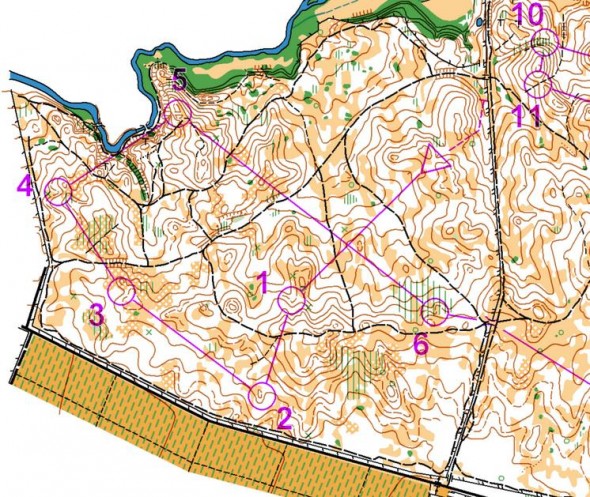
Signe Søes (Denmark) won the women’s race in her comeback – and Daniel Hubmann (Switzerland) got his revenge after the “bitter” 4th place in yesterday’s sprint. The terrain was fast and seemingly easy – but many runners did direction mistakes.
[Note! This article is based on unofficial results]
Signe Søes won her qualification heat in the voided Middle Qualification on Thursday – but had to start very early as the start list was based on the World Ranking list. From a very early start, Søes run a fantastic race – and already as she passed Radio 2 it was clear that this could very well be a medal race!
Signe Søes with very good split time at Radio 2: 4 minute lead. This COULD be a final Top 10? 6? 3? Sky is the limit! #EOC2014
— WorldofO Live (@WorldofOLive) April 14, 2014
Her gold medal chances were crushed by several small mistakes on the control points and a few direction mistakes
The only ones able to fight Søes in the first part of the course were Maja Alm (Denmark) , Tove Alexandersson (Sweden) , Ida Bobach (Denmark) and Helena Jansson (Sweden). Jansson and Bobach failed in the middle of the race – and thus the fight was only between Alm, Søes and Alexandersson.
Alexandersson looked very strong – having the highest speed – but her gold medal chances were crushed by several small mistakes on the control points and a few direction mistakes on the longer legs. In the end Alexandersson could not even beat Alm – and the day was Danish: Signe Søes the winner ahead of Maja Alm and Tove Alexandersson.
GPS comparison
Signe Søes started early, and therefore did not run with a GPS from the organizer. However, knowing that Alm was 17 seconds behind Søes at the end, it was still possible to follow the excitement on the GPS. Below is an autOanalysis comparing Alm and Alexandersson (click to enlarge); Alexandersson’s route is in blue. Alm’s route is green where she is faster than Alexandersson, red where she is slower. It is evident that Alexandersson should have used some more time on her compass – loosing time on all of the longer legs when she didn’t keep the right direction. However – there has to be an even bigger timelost after her GPS stopped working between control 16 and 17 – we’ll see that from the splits.
Daniel Hubmann, Hertner and Gueorgiou
Hubmann goes Bulldozer – and earns time on that
In the men’s class three men showed from the start that they would be the strongest today: Daniel Hubmann, Fabian Hertner and Thierry Gueorgiou. Hubmann had slightly higher speed – and they all three had a though fight all the way to the finish. Below are GPS comparisons between Hubmann and Hertner/Gueorgiou. Hertner looses time on some micro route choices around 5 and 6 – where Hubmann is tough and goes direct. Also a similar situation to 18. Hubmann goes Bulldozer – and earns time on that.
Comparing Gueorgiou and Hubmann, they are quite even until the 9th control, but then Gueorgiou starts loosing some small seconds here and there. First to 10, then to 12, then to 16 and to 18. In the end it is not enough “finesse” from the French King of Middle distance in this rather easy terrain – but the WOC terrain in Italy should fit a lot better!
Maps and GPS-tracking
- Map men
- Map women
- GPS-tracking (men and women) – including link to 2DRerun analysis
Results
Note! These are unofficial results!
Men
| 1 | 1 | 83 | 32:23 |
| 2 | 5 | 85 | 32:41 |
| 3 | 2 | 79 | 33:04 |
| 4 | 26 | 84 | 33:32 |
| 5 | 7 | 85 | 33:40 |
| 6 | 6 | 85 | 33:52 |
| 7 | 18 | 98 | 34:02 |
| 8 | 15 | 82 | 34:08 |
| 9 | 8 | 74 | 34:10 |
| 10 | 38 | 88 | 34:18 |
| 11 | 3 | 87 | 34:21 |
| 12 | 20 | 76 | 34:23 |
| 13 | 47 | 81 | 34:26 |
| 14 | 4 | 90 | 34:33 |
| 14 | 28 | 88 | 34:33 |
| 16 | 12 | 89 | 34:39 |
| 17 | 10 | 88 | 34:45 |
| 18 | 22 | 83 | 34:48 |
| 19 | 80 | 88 | 34:55 |
| 20 | 9 | 90 | 35:00 |
Women
| 1 | 274 | 83 | 30:45 |
| 2 | 213 | 88 | 31:02 |
| 3 | 201 | 92 | 31:03 |
| 4 | 220 | 83 | 31:35 |
| 5 | 206 | 81 | 32:01 |
| 6 | 216 | 82 | 32:41 |
| 7 | 204 | 84 | 32:48 |
| 8 | 215 | 87 | 32:53 |
| 9 | 202 | 91 | 33:17 |
| 10 | 228 | 90 | 33:18 |
| 11 | 211 | 90 | 33:43 |
| 12 | 224 | 87 | 33:50 |
| 13 | 222 | 91 | 33:51 |
| 13 | 230 | 80 | 33:51 |
| 15 | 247 | 93 | 33:54 |
| 16 | 209 | 86 | 34:01 |
| 17 | 205 | 85 | 34:03 |
| 18 | 226 | 83 | 34:10 |
| 19 | 210 | 88 | 34:13 |
| 19 | 218 | 82 | 34:13 |
- Preliminary results – official results will be available here
 World of O News
World of O News
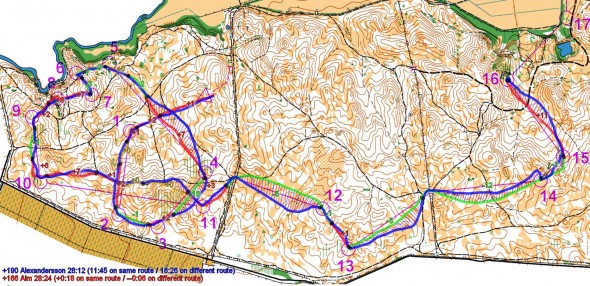

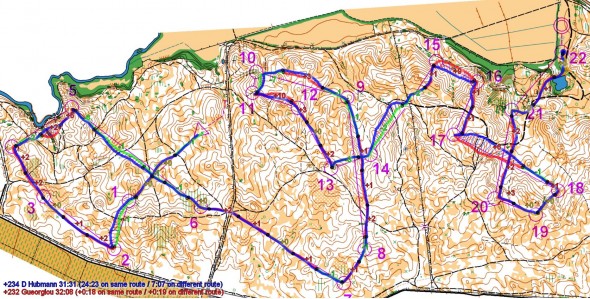
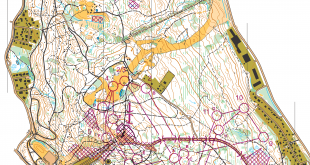
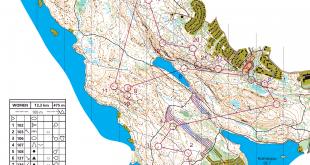
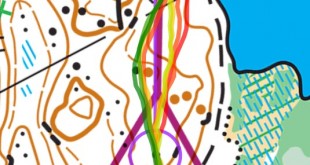
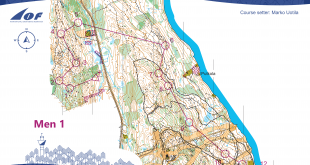
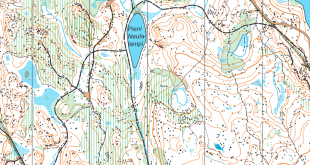
I think that Irina Nuberg didn’t use compulsory passage between eleven and twelve control points. And she got unfair advantage.
Even if Irina jumped over the fence, she should not be disqualified, because it is not forbidden, according to ISOM. Why do you think that passage is compulsory? What is an indication for it? If you say “broken purple line between controls”, then she can argue that such a break is not mentioned by ISOM by any means, so it does not mean anything.
Looking on the map and according to ISOM the fence should be more than 1.5 m high – is this true? I believe that organizers wanted to define the fence as object “forbidden to cross” otherwise why would they put passage and broke purple line towards the passage? Just to mislead the runners who are not 100% sure about ISOM rules?
Orienteering shouldn’t become preO and I suppose it is time that competition rules are fully separated from ISOM rules. If something is tend to be forbidden, out of bounds,… and it is not written yet in Competition rules than this exemption should be announced prior the race.
P.S. Why we need to wait on new ISOM if it is obvious that organizers should have been solved only a particular individual problem so we could have fair competition rules that everybody understand in the same way.
P.S.S. What kind of solution would be the most appropriate in this case?
Yes, the fence with two ticks is just a “high fence (more than 1.5 m)”. But it is allowed to jump over it, at least never forbidden in rules. Moreover, on the team leaders meeting it was explicitly said that such fences are allowed to jump over, and quite many runners jumped over them on the way to the last control.
If the organisers wanted to mark some particular fence as “forbidden to cross” there is a specifically mentioned way to do it in ISOM — they just needed to highlight it with thick purple line. Plus, mark a passage in the allowed place. However, doing the second without doing the first does not make any sense, very confusing and definitely does not forbid anything.
OK, so there is a ISOM solution which can be applied but they didn’t do it properly. This mistake could be seen in the same way as poorly mapped area IMO. More practicable solution would probably be to define high fence as object “forbidden to cross” no matter if ISSOM say differently. Do you know of any race with same mistake and the race was voided?
I do not know any race voided because of anything like this. The main problem is that all the organisers, team officials, jury members and IOF controllers have very vague ideas what the rules actually say. And do not want to know more. You can see it even in this case — the norwegian girl forced Irina to disqualify herself and all the Russian team leaders together with the jury agreed that it should be like this. As far as I see, no one even tried to read the rules.
I don’t get it. Are you saying..
a)that there was a protest from Norwegian team to disq. Irina?
b)that we have a rule which allowed Irina (runner) to fill a protest instead of team leader and disq. herself without any other official protest?
c)that the jury decided to disq. her based on GPS track and Russian team agreed?
I was looking at the same thing. Some runners actually seemed to miss that passage at first and had to make pretty drastic changes in their direction later on so that they would not miss the passage, losing a lot of valuable seconds in the process.
Hertner lost a few seconds to the 5th control, mostly because he started out going direct and changed plan. It seems Nikolov is fastest to 5th, he went straight for the crossing to the right.
Ehh.. Might be because he was on the wrong 4th, though